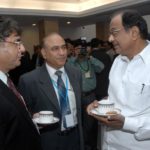 India’s Home Minister P. Chidambaram during a speech at the conference of State police chiefs and Inspector-Generals of police cautioned against the emerging phenomenon of ‘saffron terror’. The Home Minister’s comments have proved controversial with the Opposition Party, Bharatiya Janata Dal (BJP) demanding an apology. Semantics apart, Home Minister Chidambaram’s comment was not frivolous.
India’s Home Minister P. Chidambaram during a speech at the conference of State police chiefs and Inspector-Generals of police cautioned against the emerging phenomenon of ‘saffron terror’. The Home Minister’s comments have proved controversial with the Opposition Party, Bharatiya Janata Dal (BJP) demanding an apology. Semantics apart, Home Minister Chidambaram’s comment was not frivolous.
[Photo: Shanker Chakravarty; Courtesy: The Hindu]
This is what Minister Chidambaram said during his Inaugural speech at the conference: “There is no let up in the attempts to radicalise young men and women in India. Besides, there is the recently uncovered phenomenon of saffron terrorism that has been implicated in many bomb blasts of the past. My advice to you is that we must remain ever vigilant and continue to build, at the Central and State levels, our capacity in counter-terrorism.”
Use of the word ‘saffron’ has evoked more controversies than the actual phenomenon that Minister Chidambaram talked about in his speech. The word ‘saffron’ is seen by many as an indirect reference to the BJP, a Hindu right party which uses saffron in the party flag. Though Minister Chidambaram may be accused of being reckless in choosing the word saffron for depicting increasing involvement of Hindutva groups in violent activities, it is wrong to associate saffron with the color of the BJP. Saffron is seen by many Indians as the color of valor and renunciation and finds a place of pride on the Indian flag. Linking ‘saffron’ to the BJP is simplistic thinking. However, Minister Chidambaram would have been better advised to use a term that would truly communicate the phenomenon he was referring to rather than getting entangled in political controversies.
Many may continue to object to the use of the word ‘saffron’ in this context but the larger fact is that Minister Chidambaram has drawn attention to a widely growing phenomenon which has escaped public attention. Terrorism in India instinctively translates in popular imagination as a Pakistan supported phenomenon and something perpetuated by Muslim radical groups. Reality does not fully confirm to this perception and here is some evidence to highlight the changing reality.
In December 2002 explosives were recovered at Bhopal railway station ostensibly targeting Muslim passengers arriving for Tablighi Jamaat gathering. In December 2003 a bomb was found in the Lamba Khera area, on the outskirts of Bhopal, on the last day of a Talblighi Jamaat meeting. Local Hindutva activists were arrested in connection with both the incidents but were soon set free. Revelations from the Nanded blast were even more compelling. In April 2006 a bomb exploded at the residence of irrigation department engineer and RSS worker, Lakshman Rajkondawar in Nanded. Bajrang Dal activists Naresh Kondwar and Himanshu Panse killed during the bomb making incident, were responsible for bombing a mosque in the Parbhani District. The Anti-Terrorism Squad (ATS) charge sheet alleged that Bajrang Dal cadres took part in the Mohammadiya Masjid blast in Parbhani in November 2003, the Quadriya Masjid blast in Jalna in August 2004, and in the same month at the Meraj-ul-Uloom Masjid blast in Purna.
The 2007 Mecca Masjid blast in Hyderabad and the 2008 Malegaon blasts drive home the growing lethality of the violence being perpetuated by some Hindutva groups. Based on interrogation transcripts of the accused in the Malegaon case, Christophe Jaffrelot has thrown light on the role of Hindutva groups like Abhinav Bharat in inciting communal violence. Excerpts of conversations among the accused quoted by Christophe reveal a larger, though difficult to realize plot. Members of the Abhinav Bharat aimed at over-throwing the Indian state and replacing it with a code of conduct in “accordance with the Vedic procedures, we want the Sanatan Dharma, the Vedic Dharma…[and] political excommunication of people whose ideas are detrimental to Hindu Rashtra.”
All this may sound like a fanatic’s dream to most readers but such elements pose a threat to India’s internal security. Thus Minister Chidambaram’s remark calling for the police force to be vigilant against challenges from the violent Hindutva groups cannot be labeled as a false alarm.
The state agencies did draw hasty conclusions in some of the cases cited above by implicating extremist Muslim groups. For example, one victim at the Mecca Masjid blast was declared a terrorist belonging to Harkat-ul-Jehad Islami (HUJI) and held responsible for the incident. The investigating agencies can be blamed for jumping the gun and making public pronouncements without adequate investigations. The silver lining is the fact that the course has been corrected after new evidence emerged. It is heartening to see that the law enforcement and investigating agencies have set the course right and arrested the suspects – Sadhvi Pragya Singh, Lt Col Srikant Purohit, Maj (retd) Ramesh Upadhyay, Swami Dayanand and Swami Aseemanand.
Fortunately, the arrest and interrogation of the suspects, all of whom belong to Hindutva groups, is not been hyped as a specimen of India’s secular approach. Perpetuation of violence by Islamist or Hindutva groups needs to be handled with equal efficiency by the country’s law enforcement agencies. And this is what Minister Chidambaram reiterated in his speech, though his use of the term ‘saffron’ is open to speculation.